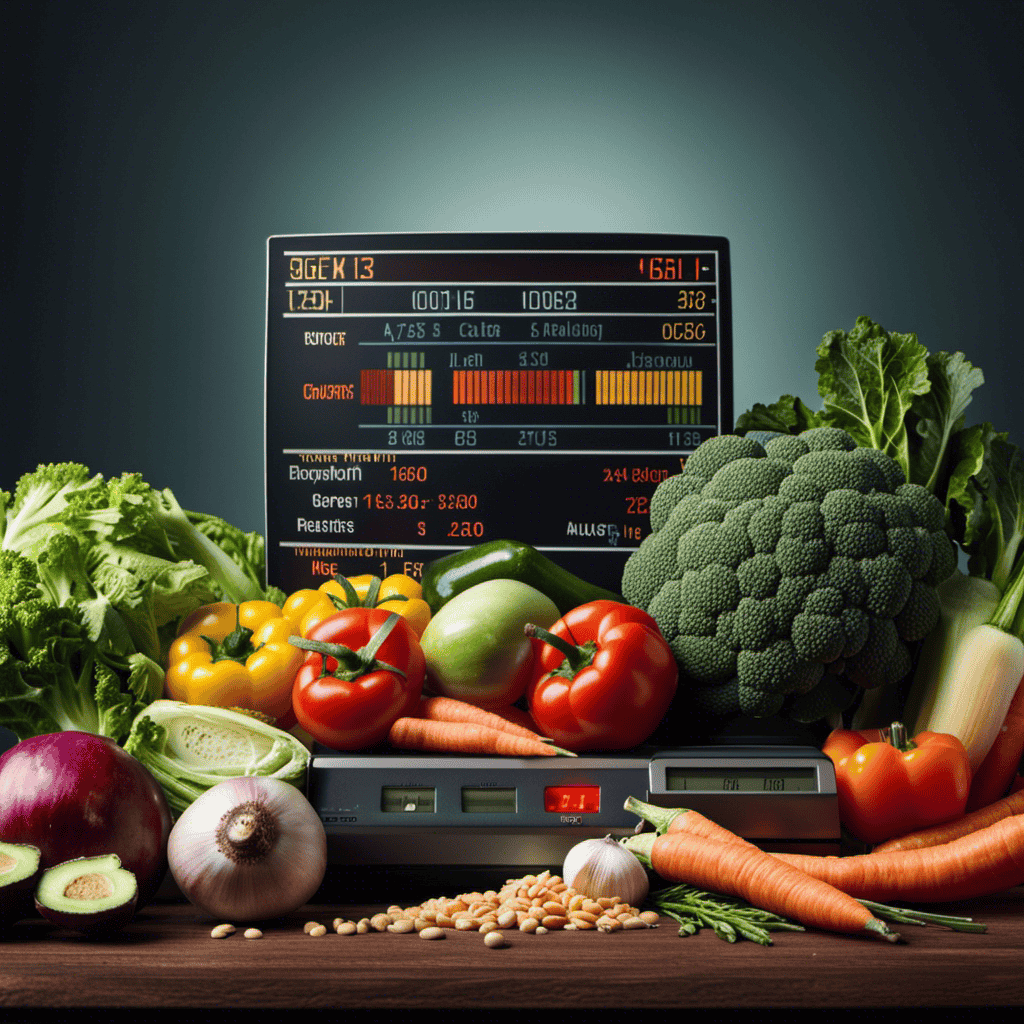Are you having trouble losing those additional pounds? Don’t worry, we can help!
In this article, we will dive into the essential process of calculating calorie needs for successful weight loss. By understanding your basal metabolic rate (BMR) and adjusting it based on your goals and activity levels, you can craft a personalized diet plan that will maximize fat burning and maintain muscle mass.
With tips on high-intensity workouts, creating a healthy diet, meal prep, and achieving safe and effective weight loss, you’ll be well-equipped to reach your fitness goals.
Let’s get started on your weight loss journey!
Key Takeaways
- Calorie calculation is crucial for weight loss success
- Adjust BMR based on desired outcome and additional activity
- Consume slightly fewer calories than recommended for fat burning in a low-calorie diet
- Consume fewer calories for maintaining muscle mass in a moderate-calorie diet
Caloric Needs for Weight Loss
To determine the caloric needs for my weight loss journey, I will calculate my basal metabolic rate (BMR) using the Harris-Benedict equation. This equation takes into account factors such as age, gender, weight, and height to provide an estimate of the calories needed to maintain my current weight.
From there, I will adjust my BMR based on my desired outcome, whether it’s to create a caloric deficit for weight loss or to maintain muscle mass with a moderate-calorie diet.
It’s important to note that individual caloric needs vary based on size and physical activity level. Additionally, incorporating high-intensity workouts into my routine will require me to consume extra calories to fuel my activities without risking injury or burnout.
Lastly, I will be mindful of weight loss plateaus and incorporate refeeds to prevent stagnation during caloric restriction.
High-Intensity Workouts and Intake
During high-intensity workouts, I multiply my basal metabolic rate by 1.2-1.7 to determine my caloric intake.
High-intensity exercises require more energy and fuel, so it’s important to adjust my calorie intake accordingly.
By increasing my caloric intake, I can provide my body with the necessary energy to perform at its best and avoid injury or burnout.
As an athlete, it’s crucial to consume extra calories to support the demands of intense training sessions.
Additionally, incorporating refeeds into my diet can help prevent plateaus during caloric restriction.
However, it’s important to seek professional help if I experience extreme fatigue or a weakened immune system.
It’s also essential to remember that individual caloric needs vary based on size and physical activity level.
By carefully calculating my calorie needs during high-intensity workouts, I can ensure that I am properly fueling my body for optimal performance and successful weight loss.
Creating a Healthy Diet
Creating a healthy diet involves incorporating whole foods, focusing on nutrient-dense options, experimenting with new recipes and spices, and avoiding processed foods high in sugar, salt, and unhealthy fats.
Here are some tips for meal planning:
-
Eat whole foods: Opt for fresh fruits, vegetables, lean proteins, and whole grains to ensure you’re getting essential nutrients and staying full longer.
-
Focus on nutrient-dense options: Choose foods that are packed with vitamins, minerals, and fiber, such as leafy greens, berries, nuts, and legumes.
-
Experiment with new recipes and spices: Trying out different flavors and cooking techniques can make healthy eating more enjoyable and help you discover new favorite dishes.
-
Stay hydrated: Drinking enough water is crucial for overall health and weight loss. Aim to drink at least 8 cups of water per day and listen to your body’s thirst cues.
By following these tips, you can create a balanced and nutritious diet that supports your weight loss goals while providing the energy and nourishment your body needs.
Meal Prep for Convenience
By prepping my meals in advance, I can ensure convenience and have nutritious options readily available throughout the week. Meal prep has become an essential part of my weight loss journey, as it helps me save time and make healthier choices.
One of my favorite time-saving strategies is to pre-cook proteins and veggies in bulk. This way, I can easily assemble a balanced and satisfying meal in no time. I also make sure to store my prepped ingredients properly to maintain their freshness and quality.
Additionally, I experiment with different recipes and spices to keep my meals interesting and flavorful. Meal prepping not only helps me stay on track with my calorie needs but also allows me to have more control over my portion sizes and avoid overeating.
It has truly been a game-changer in my weight loss journey.
Safe and Effective Weight Loss
To achieve safe and effective weight loss, I focus on setting realistic goals, prioritizing body composition over just the number on the scale, and following a nutritious diet plan that includes regular physical exercise.
When it comes to weight loss success, it’s important to have a holistic approach that encompasses both diet and exercise. Here are some key strategies that I find helpful:
-
Set realistic goals: Instead of aiming for rapid weight loss, I focus on a steady and sustainable approach. This allows me to avoid health problems and deficiencies that can arise from extreme measures.
-
Prioritize body composition: Rather than solely focusing on the number on the scale, I pay attention to my body composition. This means working towards reducing body fat and increasing muscle mass, which leads to a healthier and more toned physique.
-
Follow a nutritious diet plan: I make sure to incorporate nutrient-dense foods into my diet, such as fruits, vegetables, lean proteins, and whole grains. This provides me with the necessary nutrients and helps me stay satiated throughout the day.
-
Regular physical exercise: Exercise not only helps burn extra calories but also promotes overall health and well-being. I incorporate a mix of cardiovascular exercises and strength training to maximize results.
By following these strategies, I have found that I can achieve safe and effective weight loss while also maintaining a healthy lifestyle.
Frequently Asked Questions
How long does it take to start seeing weight loss results?
It typically takes a few weeks to start seeing weight loss results. The timeframe for weight loss varies based on factors such as calorie deficit, exercise routine, metabolism, and individual body composition.
Can I still eat my favorite foods while on a weight loss journey?
Yes, you can still enjoy your favorite foods while on a weight loss journey. By making modifications, such as portion control or healthier cooking methods, you can find a balance between indulgence and progress towards your goals.
Is it necessary to count calories to lose weight?
Counting calories can be helpful for weight loss as it provides an accurate measure of energy intake. However, intuitive eating and portion control are also important. Balancing these approaches can lead to successful weight loss while still enjoying favorite foods.
What are some common reasons for weight loss plateaus?
Weight loss plateaus can occur due to factors like metabolic adaptation, inadequate calorie deficit, or lack of variety in exercise or diet. To overcome plateaus, adjust calorie intake, vary workouts, incorporate strength training, and track progress to stay motivated.
Are there any supplements that can help with weight loss?
Supplements can be an aid in weight loss, but their effectiveness varies. Some supplements, like green tea extract and caffeine, may increase metabolism and fat burning. However, potential side effects and limited evidence should be considered before use.
Conclusion
In conclusion, calculating calorie needs is a crucial step in achieving successful weight loss. By determining our basal metabolic rate (BMR) and adjusting it based on our goals and activity levels, we can create a personalized plan for fat burning, muscle maintenance, or high-intensity workouts.
One interesting statistic to engage you is that meal prepping can save up to 6 hours per week, making it a convenient and time-saving option for maintaining a healthy diet.
Remember, setting realistic goals, focusing on body composition, and staying consistent and dedicated are key to safe and effective weight loss.









